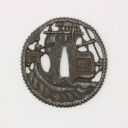Different tsuba for different folks
This tsuba with a Dutch ship design is not alone in its kind. In fact, we know of three versions of this sword guard, all with the same design. Most interestingly, they represent different levels of craftsmanship and detail.
The tsuba that we have been looking at until now demonstrates a good level of detail, as well as a beautiful gold decoration. The second tsuba is its almost exact copy, the main difference being that it doesn’t have a gold layer. Finally, the third tsuba shows the same ship design but lacks both the gold decoration as well as much of the detailing.
By looking at the three tsuba, we can confidently state that they all depict the same motif. Some specific details lead us to this conclusion: for example, the ship’s mast and rigging are in the exact same position, as are the stern galleries. The aperture for the tang also shows the same octagonal shape and surrounding wave design.
However, the three tsuba differ in several details. For example, the figurehead of the ship in the golden tsuba has distinct facial features, while facial features aren’t easily recognizable in the second tsuba. In the third one, the figurehead has disappeared completely. The golden tsuba and second tsuba share similar detailing in the waves below the ship, which are very different in the third tsuba.
This kind of observation of the tsuba’s materiality can lead us to form hypotheses about their stories. For example, the golden tsuba and the second tsuba could have been made in the same time frame, perhaps by the same hand. The lack of gilding on one of the two could be due to wanting to create different price points. We can give a tentative dating of these two by looking at the rise of tsuba that show a Dutch influence in their design, which seems to be set between 1780 and 1840.[Boxer 1931and Mandarinmansion]
There are a few theories that can be made regarding the third image. Perhaps the reduced amount of detail is due to the intention to create a cheaper object, or due to having been made by a different craftsman. Peter Dekker speculates that it could have been crafted at a later time, perhaps as a copy of the other tsuba.

